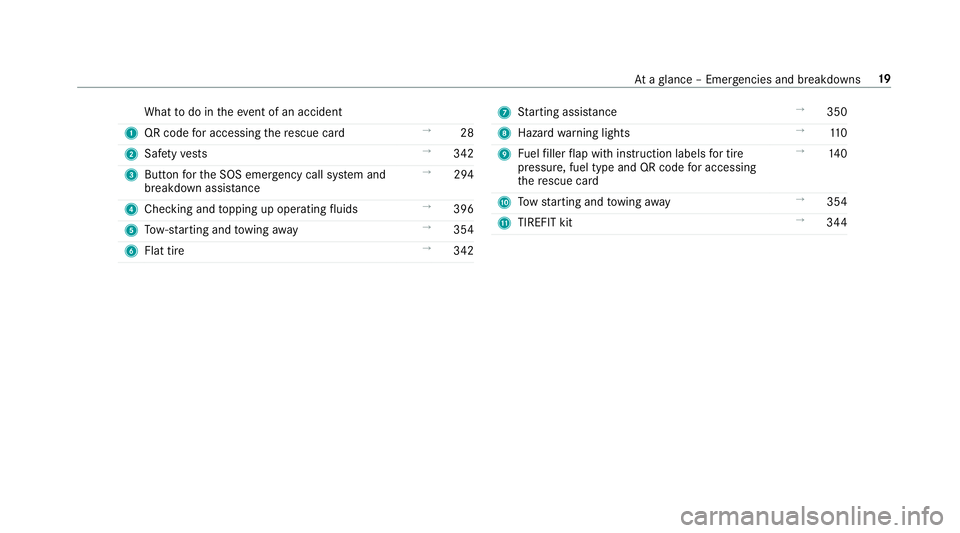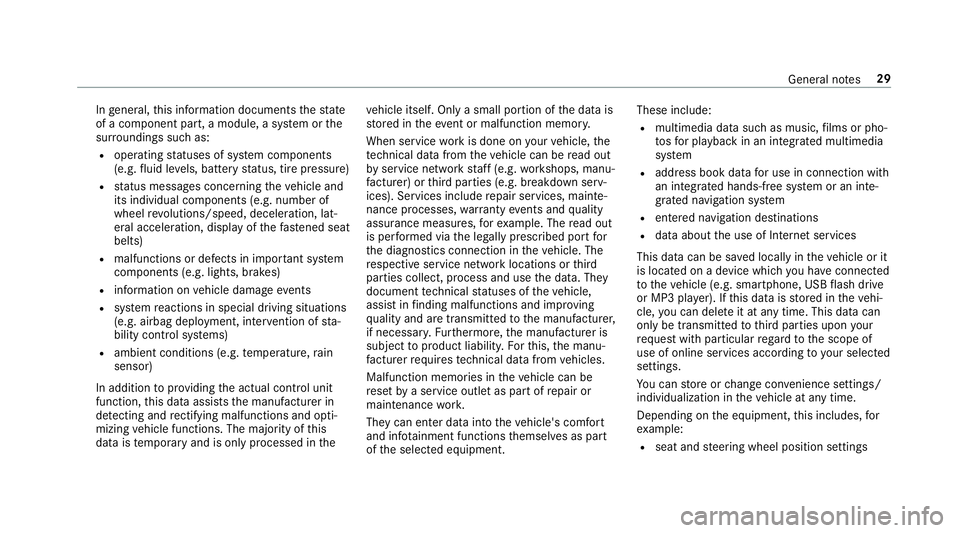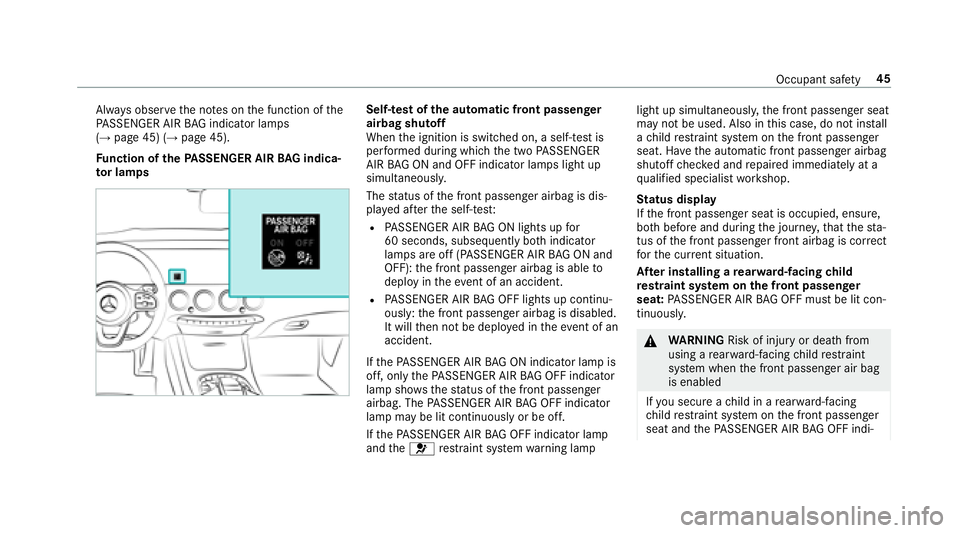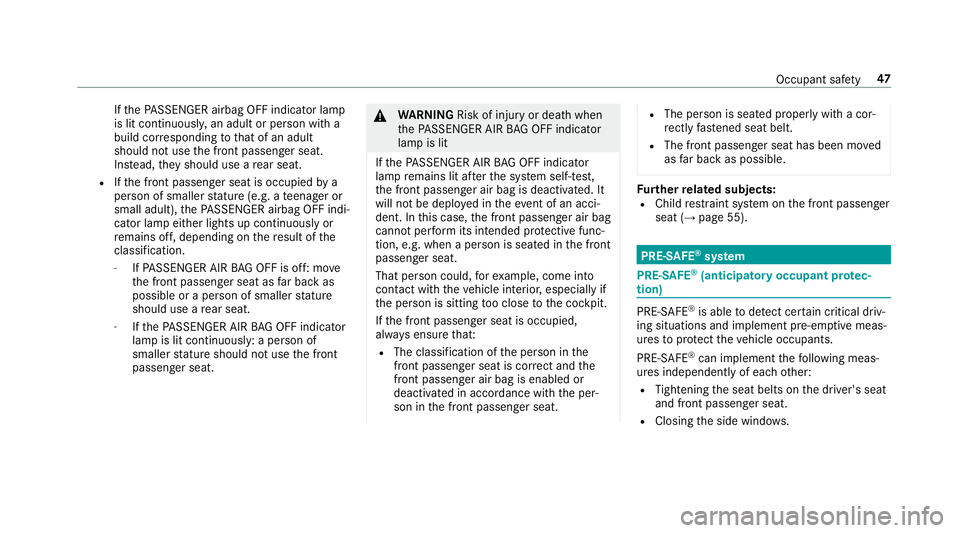lights MERCEDES-BENZ S-CLASS CABRIOLET 2018 Owner's Manual
[x] Cancel search | Manufacturer: MERCEDES-BENZ, Model Year: 2018, Model line: S-CLASS CABRIOLET, Model: MERCEDES-BENZ S-CLASS CABRIOLET 2018Pages: 502, PDF Size: 6.27 MB
Page 1 of 502

Digita
l–int hevehicl eV ehicle document walletD igital–ont he Interne tD igital–asanA pp
Fa miliarize yourself wit hthe con‐
te nts of theO perator's Manual
directly via thev ehicle's multi‐
media sy stem (menu item "Vehi‐
cle"). Startw itht he quickg uide,
disco very our vehicle's highlights
or broaden your kn owledg ewith
useful tips. Her
eyou can find comprehen‐
si ve informatio nabout operating
yo ur vehicle and about services
and warranties in printed form. Yo
uc an find theO perator's Man‐
ual on theM ercedes-Benz home‐
page. The Mercedes-Benz Guides App
is
available free-of- charge in
fa miliar App stores. ÉA2175841905/ËÍ
A2175841905 Apple
®
iOS AndroidTM Order no. P2
170174 13
Editio nB2018 Pa
rtno. A2 175841905 S-ClassC
abriolet Operator's Manual
Mercedes-BenzMercedes-Benz
S-Class Cabriolet
Page 9 of 502

1Steering wheel gearshift paddle →
139
2 Combination switch →
109
3 DIRECT SELECT le ver →
137
4 PASSENGER AIRB AGindicator lamps →
45,
45
5 Display (multimedia sy stem) →
233
6 Start/ Stop button →
129
7 Climat e control sy stems →
121
8 Glovebox →
96
9 Stow age compartment →
95
A Cup holder →
100
B Hazard warning lights →
110
C Extends there ar seat head restra ints →
85
D Parking Assist PARKTRONI C →
184
E Control elements forth e multimedia sy stem →
234
F Active Parking Assist →
192
G Sets theve hicle le vel →
176H
DYNA MIC SELECT switch →
136
I ECO start/ stop function →
135
J Control panel forth e multimedia sy stem →
209
K Adjusts thesteering wheel →
90
L Control panel for:
on-board computer →
209
Operates cruise contro l →
160
Operates Active Dis tance Assist DISTRONIC →
163
M Unloc ksthe hood →
328
N Elect ric park ing brake →
147
O Light switch →
108
P Control panel for:
Ac tive Steering Assist →
169
Ac tive Lane Keeping Assist →
206
Night View Assist →
201
Head-up Display →
218,
21 8
At aglance – Cockpit 7
Page 13 of 502

1Speedom eter →
208
2 AIR BODY CONTROL malfunctioning →
454
3 #! Turn signal light →
109
4 Multifunction display →
211
5 Tach ome ter →
208
6 å ESP
®OFF →
447
÷ ESP
®→
447
7 K High beam →
109
L Low beam →
108
T Parking lights →
108
8 ? Coolant too hot/cold →
456
9 Coolant temp erature gauge →
208
A · Distance warning →
454
B Ð Steering assis tance malfunction →
455
C # Electrical malfunction →
456
D Brakes (red) →
447
$ USA only
J Canada only
E ü Seat belt is not fastened →
454
F Fuel le vel display
G 8 Fuelreser vewith fuel filler flap location
indicator →
456,
456
H R Rear fog light →
109
I 6 Restra int sy stem →
34
J % Indicator lamp has no function
K ; Check Engine →
456
L Elect ric park ing brake applied (red) →
447
F USA only
! Canada only
M h Tire pressure monitoring sy stem →
460
N ! ABS malfunction →
447
O ! Electric pa rking brake (yellow) →
447
At aglance – Warning and indicator lamps 11
Page 21 of 502

Whattodo in theeve nt of an accident
1 QR code for accessing there scue card →
28
2 Safetyve sts →
342
3 Button forth e SOS emer gency call sy stem and
breakdown assis tance →
294
4 Checking and topping up operating fluids →
396
5 Tow- starting and towing away →
354
6 Flat tire →
3427Starting assis tance →
350
8 Haza rdwa rning lights →
110
9 Fuelfiller flap with instruction labels for tire
pressure , fuel type and QR code for accessing
th ere scue card →
140
A Tow starting and towing away →
354
B TIREFIT kit →
344
Ataglance – Emer gencies and breakdowns 19
Page 31 of 502

Ingeneral, this information documents thest ate
of a component part, a module, a sy stem or the
sur roundings such as:
Roperating statuses of sy stem components
(e.g. fluid leve ls, battery status, tire pressure)
Rstatus messages concerning theve hicle and
its individual components (e.g. number of
wheel revo lutions/speed, decele ration, lat‐
eral acceleration, display of thefast ened seat
belts)
Rmalfunctions or defects in impor tant sy stem
components (e.g. lights, brakes)
Rinformation on vehicle damage events
Rsystem reactions in special driving situations
(e.g. airbag deployment, inter vention of sta‐
bility control sy stems)
Rambient conditions (e.g. temp erature, rain
sensor)
In addition toprov iding the actual control unit
function, this data assists the manufacturer in
de tecting and rectifying malfunctions and opti‐
mizing vehicle functions. The majority of this
data is temp orary and is only processed in the ve
hicle itself. Only a small portion of the data is
st ored in theev ent or malfunction memor y.
When service workis done on your vehicle, the
te ch nical da tafrom theve hicle can be read out
by service network staff (e.g. workshops, manu‐
fa cturer) or third parties (e.g. breakdown serv‐
ices). Services include repair services, mainte‐
nance processes, warranty events a
nd
quality
assurance measures, forex ample. The read out
is per form ed via the legally prescribed port for
th e diagnostics connection in theve hicle. The
re spective service network locations or third
parties collect, process and use the data. They
document tech nical statuses of theve hicle,
assist in finding malfunctions and impr oving
qu ality and are transmitted tothe manufacturer,
if necessar y.Fu rthermore, the manufacturer is
subject toproduct liability. Forth is, the manu‐
fa cturer requirestech nical da tafrom vehicles.
Malfunction memories in theve hicle can be
re set bya service outlet as part of repair or
maintenance work.
They can enter data into theve hicle's comfort
and inf otainment functions themselves as part
of the selected equipment. These include:
Rmultimedia data such as music,
films or pho‐
to sfo r playba ckin an integrated multimedia
sy stem
Raddress book data for use in connection with
an integrated hands-free sy stem or an inte‐
grated navigation sy stem
Rentered navigation destinations
Rdata about the use of Internet services
This data can be sa ved locally in theve hicle or it
is located on a device which you ha veconnected
to theve hicle (e.g. smartphone, USB flash drive
or MP3 pla yer). If this data is stored in theve hi‐
cle, you c
an dele
teit at any time. This data can
only be transmitte dto third parties upon your
re qu est with particular rega rd tothe scope of
use of online services according toyour selected
settings.
Yo u can store or change con venience settings/
individualization in theve hicle at any time.
Depending on the equipment, this includes, for
ex ample:
Rseat and steering wheel position settings
General no tes 29
Page 36 of 502

Restra int sy stem functionality
When the ignition is switched on, a self-test is
per form ed, during which the6 restra int sys‐
te m wa rning lamp lights up. It goes out no later
th an a few seconds af terth eve hicle is star ted.
The components of there stra int sy stem are then
functional.
Malfunctioning restra int sy stem
A malfunction has occur red in there stra int sys‐
te m if:
RThe 6 restra int sy stem warning lamp
does not light up when the ignition is
switched on.
RThe 6 restra int sy stem warning lamp
lights up continuously or repeatedly during a
journe y.
&
WARNING Risk of injury orfata l injury
due toa malfunction in there stra int sys‐
te m
If th ere stra int sy stem is malfunctioning,
re stra int sy stem components may be trig‐
ge red unintentionally or might not be trig‐
ge red at all in theeve nt of an accident. This
may af fect the Emer gency Tensioning Device
or airbag, forex ample.
#Ha ve there stra int sy stem checked and
re paired immediately at a qualified spe‐
cialist workshop.
Fu nction of there stra int sy stem in an acci‐
dent
How there stra int sy stem works is de term ined by
th e se verity of the impact de tected and the type
of accident anticipated:
RFr ontal impact
RRe ar impact
RSide impact
RRo llover The activation
thre sholds forth e components of
th ere stra int sy stem are de term ined based on
th eev aluation of the sensor values measured at
va rious points in theve hicle. This process is pre-
em ptive in nature. The triggering/deployment of
th e components of there stra int sy stem must
ta ke place in good time at thest art of the colli‐
sion.
Fa ctors whi chcan only be seen and measure d
af te r a collision has occur red cann otplay a deci‐
sive role in airbag deployment, nor do they pro‐
vide an indication of airbag deployment.
The vehicle may be deformed significantly with‐
out an airbag being deplo yed. This is the case if
only parts which are relatively easily deformed
are af fected and thera te ofvehicle deceleration
is not high. Con versely, an airbag may be
deplo yedev en though theve hicle suf fers only
minor deformation. If very rigid vehicle parts
such as longitudinal members are hit, forex am‐
ple, this may result in suf ficiently high le vels of
ve hicle deceleration.
34
Occupant saf ety
Page 42 of 502

*NO
TEDeployment of the Emer gency
Te nsioning Device when the front
passenger seat is unoccupied
If th e seat belt tongue is engaged in the seat
belt buckle of the unoccupied front
passenger seat, the Emer gency Tensioning
Device may also depl oyintheev ent of an
accident along with other sy stems.
#Only one person should use each seat
belt at any one time.
Re leasing seat belts
#Press there lease button in the seat belt
buckle and guide the seat belt back with the
seat belt tongue.
Ac tivating or deactivating seat belt adjust‐
ment via the multimedia sy stem
Multimedia sy stem:
,Vehicle.î Vehicle Settings.Belt
Adjustment
#Ac tivate Oor deacti vate ª the function.
Seat belt warning function for the driver and
front passen ger
The ü seat belt warning lamp in the Instru‐
ment Display is a reminder that all vehicle occu‐
pants must weartheir seat belts cor rectly.
The ü seat belt warning lamp lights up for six
seconds af tereve ryengine start.
In addition, an acoustic warning tone may sound.
When the driver's and front passenger doors are
closed and the driver and front passenger ha ve
fast ened their seat belts, the seat belt warning
goes out. During a journe
y,the seat belt warning lights up
if:
RThe vehicle speed exceeds 15mp h
(25 km/h) and the driver's or front
passenger seat belt is not fastened.
RThe driver or front passenger unfas tens their
seat belt while theve hicle is in motion.
Airbags
Overview of airbags
1Driver's knee airbag
2Driver's airbag
40
Occupant saf ety
Page 47 of 502

Always obser vethe no tes on the function of the
PA SSENGER AIR BAG indicator lamps
(
→page 45) (→page 45).
Fu nction of thePA SSENGER AIR BAG indica‐
to r lamps
Self- test of the automatic front passenger
airbag shuto ff
When the ignition is switched on, a self-test is
per form ed during which the two PASSENGER
AIR BAG ON and OFF indicator lamps light up
simul taneously.
The status of the front passenger airbag is dis‐
pla yed af terth e self-tes t:
RPASSENGER AIR BAG ON lights up for
60 seconds, subsequently bo thindicator
lamps are off (PASSENGER AIR BAG ON and
OFF): the front passenger airbag is able to
deploy in theev ent of an accident.
RPA SSENGER AIR BAG OFF lights up continu‐
ously: the front passenger airbag is disabled.
It will then not be deplo yed in theeve nt of an
accident.
If th ePA SSENGER AIR BAG ON indicator lamp is
off, only thePA SSENGER AIR BAG OFF indicator
lamp sho wsthest atus of the front passenger
airbag. The PASSENGER AIR BAG OFF indicator
lamp may be lit continuously or be off.
If th ePA SSENGER AIR BAG OFF indicator lamp
and the6 restra int sy stem warning lamp light up simultaneousl
y,the front passenger seat
may not be used. Also in this case, do not ins tall
a ch ild restra int sy stem on the front passenger
seat. Ha vethe automatic front passenger airbag
shutoff checked and repaired immediately at a
qu alified specialist workshop.
St atus display
If th e front passenger seat is occupied, ensure,
bo th bef ore an
d during
the journe y,that thest a‐
tus of the front passenger front airbag is cor rect
fo rth e cur rent situation.
Af ter in stalling a rear wa rd-facing child
re stra int sy stem on the front passenger
seat: PASSENGER AIR BAG OFF must be lit con‐
tinuousl y.
&
WARNING Risk of injury or death from
using a rear wa rd-facing child restra int
sy stem when the front passenger air bag
is enabled
If yo u secure a child in a rear wa rd-f acing
ch ild restra int sy stem on the front passenger
seat and thePA SSENGER AIR BAG OFF indi‐
Occupant saf ety 45
Page 49 of 502

Ifth ePA SSENGER airbag OFF indica tor lamp
is lit continuously, an adult or person with a
build cor responding tothat of an adult
should not use the front passenger seat.
Ins tead, they should use a rear seat.
RIfth e front passenger seat is occupied bya
person of smaller stature (e.g. a teenager or
small adult), thePA SSENGER airbag OFF indi‐
cator la mpeither lights up continuously or
re mains off, depending on there sult of the
classifi cation.
-IfPA SSENGER AIR BAG OFF is off: mo ve
th e front passenger seat as far back as
possible or a person of smaller stature
should use a rear seat.
-Ifth ePA SSENGER AIR BAG OFF indicator
lamp is lit continuously: a person of
smaller stature should not use the front
passenger seat.
& WARNING Risk of injury or death when
th ePA SSENGER AIR BAG OFF indicator
lamp is lit
If th ePA SSENGER AIR BAG OFF indicator
lamp remains lit af terth e sy stem self-test,
th e front passenger air bag is deactivated. It
will not be deplo yed in theeve nt of an acci‐
dent. In this case, the front passenger air bag
cannot perform its intended pr otective func‐
tion, e.g. when a person is seated in the front
passenger seat.
That person could, forex ample, come into
con tact wi th theve hicle interior, especially if
th e person is sitting too close tothe cockpit.
If th e front passenger seat is occupied,
alw ays ensure that:
RThe classification of the person in the
front passenger seat is cor rect and the
front passenger air bag is enabled or
deactivated in accordance with the per‐
son in the front passenger seat.
RThe person is seated proper lywith a cor‐
re ctly fastened seat belt.
RThe front passenger seat has been mo ved
as far back as possible.
Fu rther related subjects:RChild restra int sy stem on the front passenger
seat (→page 55).
PRE-SAFE®sy stem
PRE- SAFE®(anticipa tory occupant pr otec‐
tion)
PRE- SAFE®is able todetect cer tain critical driv‐
ing situations and implement pre-em ptive meas‐
ures toprotect theve hicle occupants.
PRE-SAFE
®can implement thefo llowing meas‐
ures independently of each other:
RTightening the seat belts on the driver's seat
and front passenger seat.
RClosing the side windo ws.
Occupant saf ety 47
Page 61 of 502

respective SmartK ey.To do so, deactivate the
SmartK eyfunctions.
#To deactivate: pressthe& button on the
SmartK eytwice in quick succession.
The battery check lamp of the SmartK ey
fl ashes twice brief lyand lights up once.
#To activate: press any button on the Smart‐
Ke y.
% When theve hicle is star ted with the Smart‐
Ke yin thestow age compartment of the cen‐
te r console, theke yfunction sar eautomati ‐
cal lyactivated (
→page 130).
Re moving/inserting the eme rgency key
#To remo ve:press release knob 1.
Emer gency key2 is pushed out slight ly.
#Pull out emer gency key2 until it en gage s in
th e intermediate position.
% You can use the intermediate position of
emer gency key2 toattach theke yto ake y
ri ng.
#Press release knob 1again and fully
re mo veemer gency key2.
#To inser t:press release knob 1.
#Insert emer gency key2 tothe intermediate
position or fully until it engages.
Re placing the SmartK eybattery
&
DANG ER Serious damage tohealth
caused byswallowing batteries
Batteries contain toxic and cor rosive sub‐
st ances. Swallowing batte ries may cause
serious damage tohealth.
There is a risk of fata l injur y.
#Keep batteries out of there ach of chil‐
dren.
#If batteries are swallo wed, seek medical
attention immediately.
+ENVIRONMEN TALNO TEEnvironmental
damage causedbyimproper disposal of
batteries
Bat teries conta in pollutants. It is
illegal todispose of them with the household
ru bbish.
#
Dispose of batteries in an
environmen tally responsible manner.
Ta ke dischar ged batteries toaqu alified
specialist workshop or toa collection
point for used batteries.
Opening and closing 59